 W
WThis list is an alphabetical glossary of Australian rules football terms, jargon and slang. While some of these entries are shared with other sports, Australian rules football has developed a unique and rich terminology.
 W
WThe sport of Australian football has been called by a number of different names throughout its history. Since 1905, the game has been officially called "Australian football" after the formation of the Australasian Football Council. The name has been codified by the sport's governing body, the AFL Commission, as the game's official name in the "Laws of Australian football". Historically, the sport has been called "Victorian rules", the "Victorian game", the "bouncing game", "Australasian rules", the "Australian game" and "national football", as well as several other names. Today, the common names for the sport are "Australian rules football" or "football", and common nicknames for the sport are "footy", "Aussie rules" or sometimes "AFL".
 W
WIn the sport of Australian rules football, each of the eighteen players in a team is assigned to a particular named position on the field of play. These positions describe both the player's main role and by implication their location on the ground. As the game has evolved, tactics and team formations have changed, and the names of the positions and the duties involved have evolved too. There are 18 positions in Australian rules football, not including four interchange players who may replace another player on the ground at any time during play.
 W
WA ball-up in Australian rules football describes a method of restarting play at a neutral contest after a stoppage within the field of play. It is not to be confused with a boundary throw-in which occurs in most cases when the ball is forced out of bounds. Ball-ups may be considered to be the equivalent of a jump ball, faceoff or dropped-ball. Historically they were performed in most cases by a field umpire throwing the ball firmly into the ground such that it bounces directly upwards several metres into the air. They are also known as bouncedowns.
 W
WIn Australian rules football, a banner is a large crêpe paper and sticky-tape banner constructed by each team's cheer squad. It is hoisted before the start of a match, and typically shows an encouraging or celebratory message to the team; then, as the players take to the field, they run through the banner, breaking it. Traditionally, the captain, or a milestone-achieving player leads the team when breaking the banner.
 W
WThe rules of Australian rules football were first formed by the Melbourne Football Club in 1859, and been refined over the years as the game evolved into its modern form. The laws significantly predate the advent of a governing body for the sport. The first national and international body, the Australasian Football Council, was formed in 1905 to govern Australian Football. Since 1994, the rules for the game known as Australian football have been governed by the AFL and the organisation's Laws of the Game committee.
 W
WBoundary rider is a long-established (1864) Australasian term for a cattle or sheep station employee whose duties entail a regular tour of the outer perimeter (boundary) of the property, checking condition of fences, collecting stock that may have escaped and ejecting strays that may have wandered onto the property, effecting any repairs that may be required, and reporting anything out of the ordinary to the owner or manager. On larger properties semi-permanent shelters may be provided for overnight accommodation, riders generally carrying their own swags.
 W
WA captain of an Australian rules football team, sometimes known as a skipper is a player who, during the course of a match and off the field, has several additional roles and responsibilities over and above those of a regular player.
 W
WIn the sport of Australian rules football, each of the eighteen players in a team is assigned to a particular named position on the field of play. These positions describe both the player's main role and by implication their location on the ground. As the game has evolved, tactics and team formations have changed, and the names of the positions and the duties involved have evolved too. There are 18 positions in Australian rules football, not including four interchange players who may replace another player on the ground at any time during play.
 W
WA free kick in Australian rules football is a penalty awarded by a field umpire to a player who has been infringed by an opponent or is the nearest player to a player from the opposite team who has broken a rule.
 W
WIn sport, a goal may refer to either an instance of scoring, or to the physical structure or area where an attacking team must send the ball or puck in order to score points. The structure of a goal varies from sport to sport, and one is placed at or near each end of the playing field for each team to defend. For many sports, each goal structure usually consists of two vertical posts, called goal posts, supporting a horizontal crossbar. A goal line marked on the playing surface between the goal posts demarcates the goal area. Thus, the objective is to send the ball or puck between the goal posts, under or over the crossbar, and across the goal line. Other sports may have other types of structures or areas where the ball or puck must pass through, such as the basketball hoop.
 W
WA guard of honour (GB), also honor guard (US), also ceremonial guard, is a guard, usually military in nature, appointed to receive or guard a head of state or other dignitaries, the fallen in war, or to attend at state ceremonials, especially funerals. In military weddings, especially those of commissioned officers, a guard, composed usually of service members of the same branch, form the Saber arch. In principle any military unit could act as a guard of honour. However, in some countries certain units are specially designated to serve as a guard of honour, as well as other public duties.
 W
WA guernsey, or gansey, is a seaman's knitted woollen sweater, similar to a jersey, which originated in the Channel Island of the same name, sometimes known as a knit-frock in Cornwall, especially Polperro.
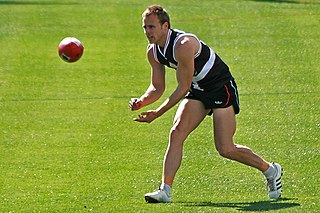 W
WHandball or handpass is a skill in the sport of Australian rules football. It is the primary means of disposing of the football by hand, and is executed by holding the ball with one hand and punching it with the other.
 W
WHolding the ball is an infraction in Australian rules football. The rule results in a free kick being awarded against a player if they fail to correctly dispose of the football upon being tackled by an opponent, although not under all circumstances. The rule provides the defending team a means to dispossess a player who is running with the football, as well as preventing players from slowing the play.
 W
WIn sport, a huddle is an action of a team gathering together, usually in a tight circle, to strategize, motivate or celebrate. It is a popular strategy for keeping opponents insulated from sensitive information, and acts as a form of insulation when the level of noise in the venue is such that normal on-field communication is difficult. Commonly the leader of the huddle is the team captain and it is the captain who will try to inspire other team members to achieve success. Similarly after an event a huddle may take place to congratulate one another for the team's success, or to commiserate a defeat. The term "huddle" can be used as a verb as in "huddling up."
 W
WInterchange is a team position in Australian rules football, consisting of players who are part of the selected team but are not currently on the field of play.
 W
WIn the sport of Australian rules football, a kick-in is the common name for the procedure to restart the game after a behind. It involves a defender from the team who did not score kicking the ball back into play from the defensive goal square.
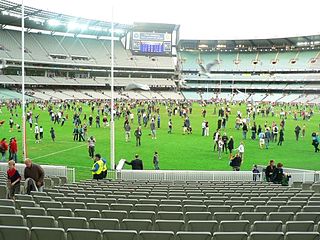 W
WKick-to-kick is a pastime and well-known tradition of Australian rules football fans, and a recognised Australian term for kick and catch type games. It is a casual version of Australian rules.
 W
WA mark is a skill in Australian rules football where a player cleanly catches a kicked ball that has travelled more than 15 metres without any other player touching it or the ball hitting the ground.
 W
WThe place kick is a type of kicking play commonly used in American football, association football (soccer), Canadian football, rugby league, and rugby union.
 W
WThe punt kick is a common style of kicking in Australian rules football. It is a kick where the ball is dropped from the players' hands and kicked slightly off the longer center line of the ball before it hits the ground. It is the primary means of kicking the ball in Australian football and is similar to punts used tactically in other football codes, such as American and Canadian football.
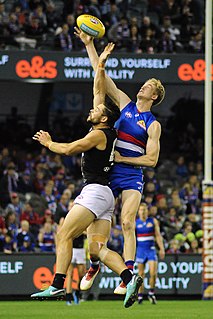 W
WIn Australian rules football, a ruckman or ruckwoman is typically a tall and athletic player who contests at centre bounces and stoppages. The ruckman is one of the most important players on the field. They are often key to coaching strategy and winning centre clearances which result in the most goal kicking opportunities.
 W
WA running bounce, or simply bounce, is a skill in the sport of Australian rules football when a player, while running, bounces the ball on the ground and back in their hands.
 W
WA set shot in Australian rules football is a kick for goal in which the player can 'set' themselves, rather than have to quickly react during the play. A set shot occurs when a player has been awarded a free kick, or has taken a mark within kicking range of the goal. There is always one opponent allowed to be "on the mark", who can attempt to distract the kicker by gesticulation or verbal intimidation. The game clock continues to run during the preparation for a set shot, although time on may temporarily be blown to return the football to the kicker.
 W
WA spectacular mark is a mark in Australian rules football that typically involves a player jumping up on the back of another player.
 W
WIn team sports, the number, often referred to as the uniform number, squad number, jersey number, shirt number, sweater number, or similar is the number worn on a player's uniform, to identify and distinguish each player from others wearing the same or similar uniforms. The number is typically displayed on the rear of the jersey, often accompanied by the surname. Sometimes it is also displayed on the front and/or sleeves, or on the player's shorts or headgear. It is used to identify the player to officials, other players, official scorers, and spectators; in some sports, it is also indicative of the player's position.
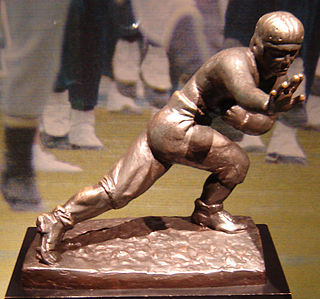 W
WThe stiff-arm fend is a tactic employed by the ball-carrier in many forms of contact football.
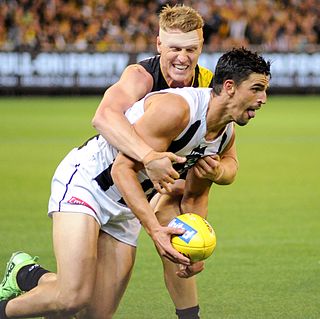 W
WMost forms of football have a move known as a tackle. The primary and important purposes of tackling are to dispossess an opponent of the ball, to stop the player from gaining ground towards goal or to stop them from carrying out what they intend.
 W
WA throw-in is a method of restarting play in a game of association football when the ball has exited the side of the field of play. It is governed by Law 15 of The Laws Of The Game.
 W
WAn umpire is an official in the sport of Australian rules football who adjudicates the game according to the "Laws Of The Game", the official handbook of Australian Rules Football.